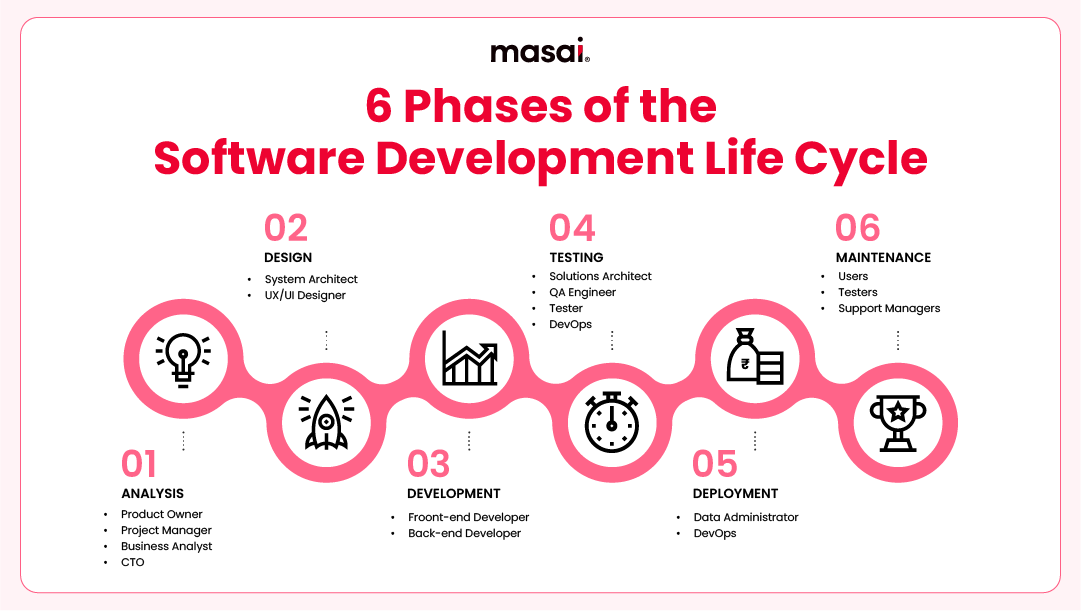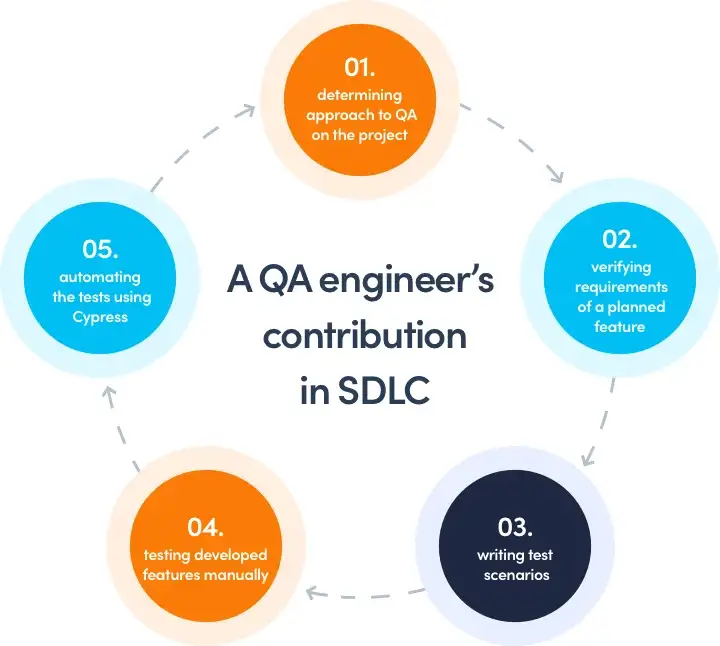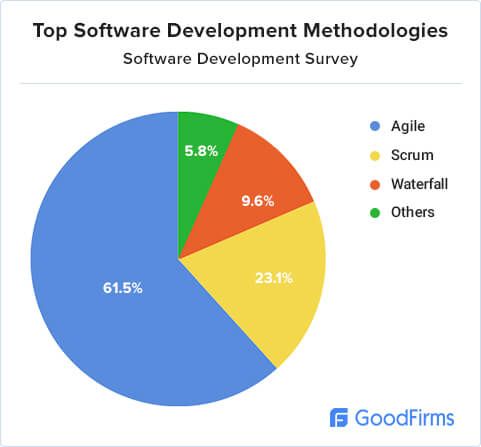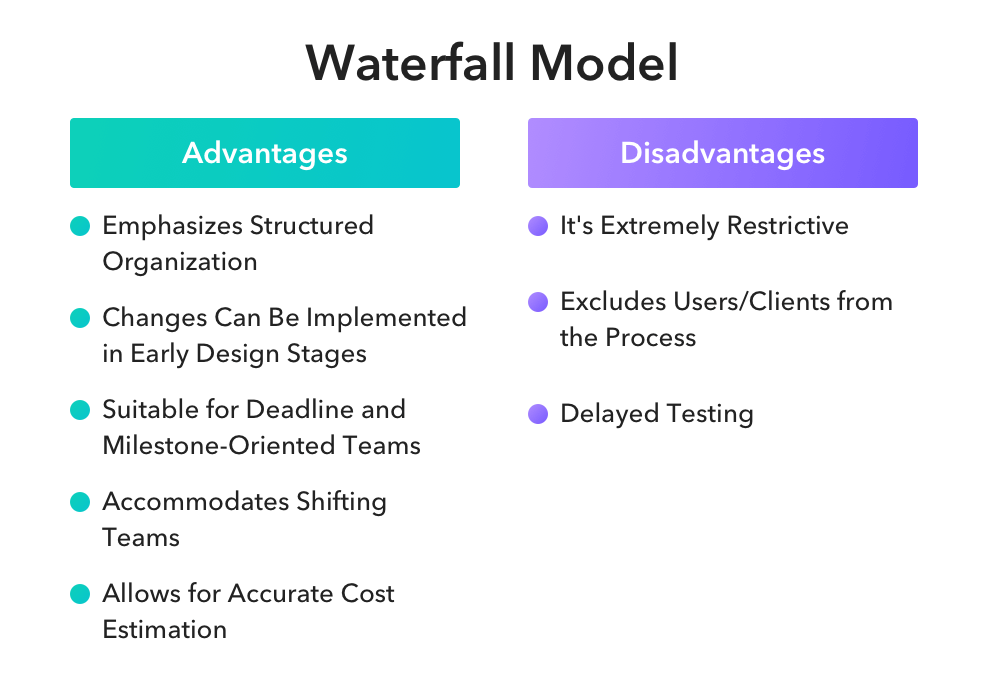How Software is Developed? A Step-By-Step Guide
We got into a conversation with Amit Saharan(Director of Technology, Masai) on how the team went about the software development life cycle and completed the MSAT project.

Learn about the intriguing process of creating software, from concept to code. In our thorough guide, learn about the complex procedure of how software is painstakingly created, constructed, and perfected.
We got into a conversation with Amit Saharan(Director of Technology, Masai) on how the team went about the software development life cycle and completed the MSAT project.
Introduction
If the 18th and 19th century was all about the industrial revolution, we can say without a tint of doubt that the 21st century has been dictated by the software revolution, and will be so until some other alien phenomenon arrives on the planet. (We don’t hope for it, though).
The software revolution’s trajectory is similar to the Industrial Revolution, albeit way faster. George Gilder, a famous American investor, and the author has called today’s software cloud data centers “information factories.”
And millions of people are working in these factories. And millions more are pursuing the field of software development. Today, the software is the solution to every new problem that arises- it’s raining outside and you have no food? There’s an app for that. Need to split a bill among your friends? There’s another app.
Need to group raw data and derive results? Oh, we have Excel. There’s even an app today to wake you up in case you’re unaffected by alarm clocks. (We’re not kidding!)
For people who’re not that familiar with the technology, all of this might seem like magic. But for people who are building this software, it’s a process.
And in this article, we’ll delve deep into that process. How software is developed exactly? What all goes into it? How many people contribute to building software that is used by billions around the world? Can you also develop one?
Let’s get started:
What is Software?
We’ve all studied the definition of a computer may be in our primaries. “A computer is an electronic device that takes input and gives the desired output”
But, what’s this input? Moreover, how does the computer understand this input?
And for that exact reason, we have software. Software is a set of instructions that tells the computer what to do. It’s in the form of binary code 0s and 1s which is an executable file that the computer understands.
Software is a tool that directs a computer's actions. Technically speaking, "software" refers to a collection of instructions, information, or programs that control computers and carry out particular functions. It is the exact opposite of hardware, which refers to the computer system's physical components. Applications, scripts, and programs that run on a device are all referred to as software.
Google Chrome, Gmail, Adobe Reader, Microsoft Word, PowerPoint, and many other comparable programs that we frequently use in our daily lives are some typical instances of the software.
It is a non-physical entity that can be stored on a computer's hard drive or other storage media. Software can range from simple programs such as a calculator or text editor to complex systems like operating systems, databases, and games.
Let's look at an example to better understand this: Assume you're generating a document in MS-word; Ms-word is the software, and we offer input from the keyboard; the computer processes the data and displays the results on the screen. Now you understand how a computer accepts data, processes it, and outputs results, but for this specific operation, writing a paper, we require software such as Microsoft Word.
So, do we have to write the software in a binary language? That would be quite tedious, isn’t it? That’s why various programming languages were developed that you hear of such as Java, Python, JavaScript, C, C++, etc. to write these programs.
The software industry is constantly evolving, producing new and improved programs to meet the changing needs of users. The development and maintenance of software require the expertise of software engineers and developers.
Why do we need to develop software?
Software is developed to solve problems, automate processes, and provide a user-friendly interface for users to interact with computers, devices, and systems.
The development of software is driven by the need for innovation and the desire to improve the way people live, work, and communicate.
Companies use software to streamline processes, increase productivity and remain competitive in their respective markets.
The prevalence and use of software in all tasks make it crucial as well. Software stores combines, and centralises data in the age of digitisation so that we may access it. Additionally, software innovations take your data's security and safety into mind.
Today, it’s a key factor in the advancement of technology and helps to shape the future.
Now that we’ve gotten a decent idea of what software is, let’s get right into the heart of the subject and understand how it is developed.
Who can profit from the development of software?
Software developers, programmers, and development teams are not the only people who work on software development projects. Even though they are not software developers, professionals, including scientists, hardware designers, device fabricators, testers, and many more, can code.
According to Statista's most recent reports, 5.8 trillion US dollars will be spent globally on information and communication technology (ICT) by 2023. With the rise in digital demand, non-ICT spending is also anticipated to increase and might top 4.5 trillion US dollars.
Software development is essential for any firm today, regardless of industry. It makes no difference what industry or size your company falls under. Software can be advantageous in one way or another.
How is software developed?
In a nutshell:
Any program that is written in a human-readable language is termed source code, and this source code is transformed into an executable file using the compilation process. As illustrated in the figure below, it’s an example of a basic C program source code being converted into software.

Now, this was a simple program and might only take one developer a short amount of time to successfully compile it. However, we’re writing this article considering professional software built by big companies that require hundreds if not thousands of developers and other associated professionals, and a reasonable amount of time to create. The process of building professional software such as the ones we use in our daily lives is quite complicated and is divided into multiple phases.
Software Development Life Cycle
The time period between the beginning of product development to the deployment of its final version is known as the software development life cycle.
It is used to describe the different stages involved in the creation of software and ensures that software is developed in a systematic and consistent manner and that all stakeholders have a clear understanding of the development process.
The different stages generally include-
- Requirements gathering and analysis: Understanding what the software is supposed to do and documenting the requirements.
- Design: creating a plan for how the software will meet the requirements.
- Implementation or coding: writing the actual code for the software.
- Testing: evaluating the software to ensure it meets the requirements and works as expected.
- Deployment: installing the software on computers or servers for use by end-users.
- Maintenance: fixing bugs, making improvements, and providing ongoing support.

Recently, the Masai team built an in-house software called MSAT to conduct admission tests for students. We got into a conversation with Amit Saharan(Director of Technology, Masai) on how the tech and the product team went about the software development life cycle and completed the project.
We've incorporated some of his input in this article for you to better understand the process. Stay tuned.
Brainstorming
Because of all the brand-new IT products and technological advancements that have been introduced in recent years, it can be difficult to come up with unique ideas. Due to several off-the-shelf solutions, product and project managers must collaborate with developers to think globally and, generally, provide something unique when developing software desired by the market.
In the IT world, brainstorming is a useful strategy. It is a creative way to identify the best ideas and solutions that can be put into practice during the SDLC. During the brainstorming session, everyone participates and offers their thoughts.
Amit Saharan(Director of Technology, Masai) had this to say about the process:
“We were using a third-party solution to take admission tests. The problem was that we were spending a lot of money, and the third-party platform was not customizable, so we had a lot of discussions and came up with the idea that we should make the system configurable and extensible. Also, we decided to build it as a micro-service so that later on, it can be integrated with our internal LMS(which is currently in progress).”
As you can see, project planning impacts how everything will be done and the entire development process.
Business Analysis
The CEO and other team members must do a feasibility analysis before making significant investments in the project. The feasibility study analyses all elements, including economic and technological ones, that have an impact on the project's development and can demonstrate how to make your own software lucrative in the long run.
Each team member, including testers, developers, project managers, and others, must estimate the amount of time, effort, and resources required to execute the particular tasks. It will assist in calculating all costs, thus making the efforts and execution precise and calculated.
Amit- “We did a cost analysis: it was cost-effective. Then we explored technologies we had to use in the project, like AWS Rekognition and SQS, and explored options for the database.”
Design
The product is conceptualized during the design phase of the SDLC. The specifications created during the first two stages of software development are used to guide the design process. Designers construct the entire project's structure, just like other architects, and offer the finished prototype that will be applied to the following stages of software development.
Amit: “For MSAT, we got the UI/UX designers to create the basic wireframes first, then had a couple of discussions, and after that, we made high-fidelity designs using the Masai Design System.”
Programming/Coding
Developers get into the coding part at this stage. Each programmer is in charge of a specific list of coding tasks for software development. The project managers are in charge of the software development process. The longest operation takes place during this period.
Codeacademy explains programming with a useful metaphor:
“Put simply, programming is giving a set of instructions to a computer to execute. If you’ve ever cooked using a recipe before, you can think of yourself as the computer and the recipe’s author as a programmer. The recipe author provides you with a set of instructions that you read and then follow. The more complex the instructions, the more complex the result!”
Integration
In order to construct a software program effectively, integrating all sources and environments is essential since it enables early identification of issues, conflicts, and bugs.
Amit: “We set up a database, backend repository, and frontend repositories - admin and student and integrated AWS-SDK. We set up test, staging, and production environment.”
Continuous integration is used by most teams, particularly agile ones. These teams run automated compilation tests and unit tests.
Quality Assurance
Engineers in quality assurance (QA) check the developer's code for errors. To find out if there are any bugs in the system, they employ several frameworks and testing techniques.

In addition to writing test cases and reporting issues to developers for correction, testers also contribute to the most effective way to construct software products.
Product release
The releases of product's subsequent versions will come after the initial software release. It is the last phase of development, and maintenance and support may come after it.
Amit: “Finally, the day came when we made the production release. Before this, we set up a test and staging environment to test all the features before releasing them.”
Software Development Methodologies and Frameworks
Different software development approaches have different benefits and drawbacks that might be considered depending on the characteristics and priorities of a project. Agile software development is the most popular methodology in 2021, but it is by no means the only one used by software development teams and their managers. Agile software development is a flexible, iterative approach to the software development lifecycle.

For software development, some of the prevalent techniques and methodology frameworks are as follows:
Waterfall Model
According to the waterfall model, each stage must be finished before moving on to the following. For instance, QA engineers don't begin testing until the development is finished.
It was one of the earliest models of software development and is still widely used today. It’s a linear, sequential approach to software development that can result in a slow and rigid process, and makes it difficult to respond to changing requirements or customer needs.

Despite these limitations, the Waterfall model is still used today in cases where the requirements for a software project are well understood and unlikely to change, and where a structured, sequential approach is desirable.
Lean
Lean software development is a methodology that emphasizes speed, efficiency, and continuous improvement. It is based on the principles of the Lean manufacturing method, which originated in the automotive industry and was later adapted for software development.
The main objective of Lean software development is to eliminate waste and maximize value for the customer by delivering software faster and with higher quality. It emphasizes collaboration and communication, rapid experimentation, and continuous improvement. The key practices of Lean software development include:
- Defining value from the customer's perspective
- Creating a minimum viable product (MVP) as quickly as possible
- Measuring progress and using data to make decisions
- Continuously experimenting and learning from failure
- Empowering teams and individuals to make decisions and take ownership of their work
Lean software development helps organizations to be more responsive to changing market conditions and customer needs, and to produce software that better meets the needs of its users.
Scrum
This model divides development work into sprints, which typically run two to four weeks and involve a cross-functional team working to provide a usable product increment. Scrum's primary roles are:
Product Owner: is in charge of creating the product backlog and ensuring that the team is working on the most important items.
Scrum Master: is in charge of guiding the Scrum process and eradicating any hurdles that the team may encounter.
Development Team: a cross-functional group of professionals in charge of delivering product increments.
Scrum stresses frequent, daily stand-up meetings (dubbed "Scrum meetings") to foster transparency, cooperation, and continual feedback. The emphasis is on delivering useable software as rapidly as feasible while also improving the process with each sprint. Scrum enables firms to be more responsive.
Agile
Agile is a form of incremental methodology where the improvement of software quality is the main goal of each release. Because it demonstrates a continuous process and quick outcomes, this methodology is extensively used by teams and customers.

Here, the length of time for each construction can be expressed in weeks as opposed to months. This is a well-liked approach that helps many business people understand how to develop software products.
DevOps
It emphasizes collaboration, automation, and continuous delivery. DevOps aims to improve the efficiency and agility of the software development process by allowing developers and operations teams to collaborate more effectively.
DevOps practices include the following:
Continuous integration and continuous delivery (CI/CD): Automating software development, testing, and deployment.
Infrastructure as code (IaC) is the practice of treating infrastructure as code that can be version-controlled, tested, and distributed in the same way that application code is.
Automated testing: The process of automating the testing process in order to quickly and efficiently detect and fix faults.
Monitoring and logging: Monitoring the performance and health of production software, as well as logging any issues or errors that may arise.
Collaboration and communication: Encouraging collaboration and communication between development and operations teams to ensure that everyone is working toward the same goals.
DevOps enables enterprises to produce software more quickly and with higher quality by breaking down conventional boundaries between development and operations teams and allowing them to operate more effectively together.
Types of Software
There are several ways to categorize software, but one common method is to classify it into four types:
System software: This type of software provides the underlying infrastructure for other software to run on. Examples of system software include operating systems (such as Windows or Linux), device drivers, and utility programs.
Application software: This type of software is designed to perform specific tasks for the user. Examples of application software include word processors, spreadsheets, and graphic design software. It can be characterised as an end-user programme that aids in task completion and the achievement of desired results. The user of the product, program, or software is referred to as the end-user in this context. Application software can be a single piece of code or a collection of programs that work together to operate the software on the user's behalf.
Depending on the user's demands, application software is loaded on a computer or mobile device. Given that this is the most prevalent kind of software, the market offers a wide range of choices.
Web-based software: This type of software is delivered over the internet and runs in a web browser, rather than being installed locally on a user's computer. Examples of web-based software include online email services, social media platforms, and project management tools.
Mobile software: This type of software is designed to run on mobile devices, such as smartphones and tablets. Examples of mobile software include games, navigation apps, and productivity tools.
Each type of software has its own unique features and functionalities, and they all play a crucial role in helping users to accomplish various tasks and achieve their goals.
Where can I get an experienced development team?
Hiring a specialised development team can be very complicated, especially if you are unfamiliar with the process and have a wide range of options available to you. If someone needs to employ a fantastic, committed development team, they must first locate one. Google can certainly be used for this endeavour, but the sheer volume of results can quickly become overwhelming.
At first glance, selecting the ideal committed team may seem difficult. However, focusing on the right area and restricting the results can be quite helpful. Several well-known platforms include
1. Platforms for contractors like Upwork
2. B2B websites like Clutch and Good companies
3. StackOverflow or GitHub
Wrapping up
That brings us to the end of this article. Of course, there are a lot of other elements that we couldn't cover in this article such as the different programming paradigms, frameworks and libraries, software development tools, etc. We'll surely cover the rest in another article.
The idea was to give you an overview of the development process and what all phases a potential product goes through before being deployed for users. And how different individuals and teams come together to build a solution, how different methodologies are used depending on the project requirements.
If you're intrigued by the software development process and you see yourself working on similar projects in the future as a developer, you might want to check out the different courses we offer at Masai. You get to learn and practice at the same time with our industry-oriented curriculum.
The catch?
You pay us nothing until you get placed for a minimum threshold income of INR 5 LPA(10 LPA in case of MasaiX).
Cheers!
FAQs
Are there opportunities for full-stack development courses online or in person?
Yes, you can get full-stack development courses both online and in person. While in-person classes offer a regulated classroom setting, online courses are frequently more flexible and let you learn at your own speed.
What is the price of a full-stack development course?
The price varies widely depending on the provider and type of course. While college and university programmes may be more expensive, boot camps and online courses can cost anything from a few hundred to several thousand dollars. There may be alternatives for financial aid and scholarships.
Important Resources:
Understanding SDE Levels- SDE-1 vs SDE-2 vs SDE-3 Differences
All you need to know about Masai's Full-Stack Developer Course
11 Mistakes to Avoid While Starting a Career in Tech

